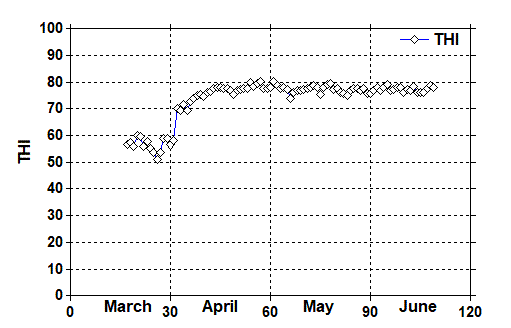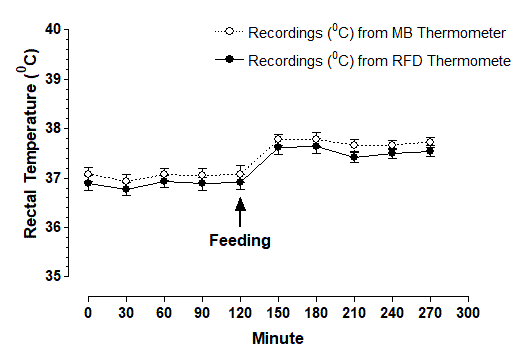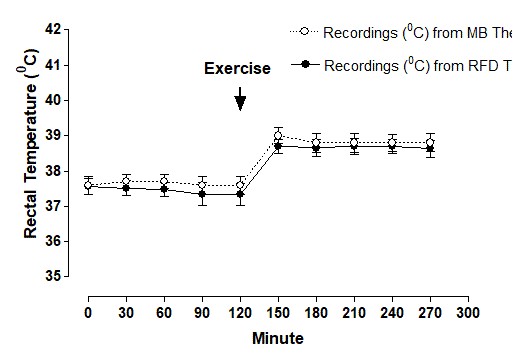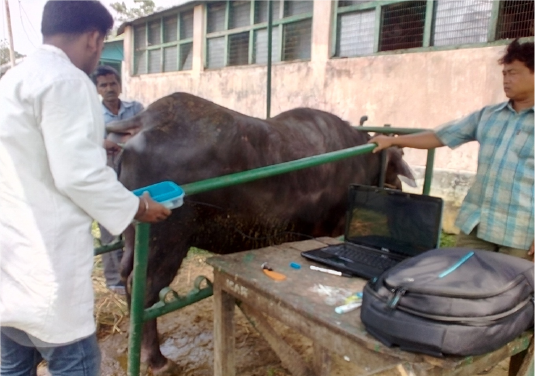Journal of Animal Health and Production
Research Article
Radio-frequency Based Digital Thermometer for Real-time Monitoring of Rectal Temperature in Murrah Buffaloes
Tridib Debnath1,2, Santanu Bera2, Suman Deb3, Prasenjit Pal4, Saptak De1, Avijit Haldar1*
1ICAR-Agricultural Technology Application Research Institute (ATARI), Indian Council of Agricultural Research, Bhumi Vihar Complex, Block- GB, Sector- III, Salt Lake, Kolkata- 700097, West Bengal, India; 2Department of Livestock Production Management, West Bengal University of Animal and Fishery Sciences, 37, K. B. Sarani, Kolkata- 700037, West Bengal, India; 3Computer Science and Engineering Department, National Institute of Technology, Agartala, Tripura, India; 4College of Fisheries, Central Agricultural University, Lembucherra- 799210, West Tripura, India.
Abstract | Real-time monitoring of body temperature in livestock for detecting the febrile condition, oestrus, heat stress, onset of calving etc is limited. Thus, the aim was to validate real-time rectal temperature (RT) data of radio frequency based digital (RFD) thermometer with RT data of mercury bulb (MB) thermometer in female Indian Murrah buffaloes (Bubalus bubalis). In experiment I, six buffaloes were used to record RT for 2 h on empty stomach and 2 h after feeding at 0, 30, 60, 90 and 120 min using RFD thermometer as well as MB thermometer. In experiment II, six buffaloes were again used to record RT for 2 h before exercise and 2 h after exercise at 0, 30, 60, 90 and 120 min. Two way repeated measures analysis of variance (ANOVA) with post hoc comparisons by Bonferroni test showed that there was no significant difference (P>0.05) between RT data recorded by RFD thermometer as well as MB thermometer throughout the monitoring period. The RT data recorded by RFD thermometer and by MB thermometer were increased (P<0.05) following feeding and exercise in buffaloes. The results obtained in the present study suggest that the body temperature recordings from RFD thermometer could be used for monitoring real-time RT in buffaloes.
Keywords | Radio-frequency device, Thermometer, Body temperature, Buffalo, Murrah
Received | June 20, 2019; Accepted | September 02, 2019; Published | December 22, 2019
*Correspondence | Avijit Haldar, ICAR-Agricultural Technology Application Research Institute (ATARI), Indian Council of Agricultural Research, Bhumi Vihar Complex, Block- GB, Sector- III, Salt Lake, Kolkata- 700097, West Bengal, India; Email: vetavijit@gmail.com
Citation | Debnath T, Bera S, Deb S, Pal P, De S, Haldar A (2019). Radio-frequency based digital thermometer for real-time monitoring of rectal temperature in murrah buffaloes. J. Anim. Health Prod. 7(4): 142-146.
DOI | http://dx.doi.org/10.17582/journal.jahp/2019/7.4.142.146
ISSN | 2308-2801
Copyright © 2019 Haldar et al. This is an open access article distributed under the Creative Commons Attribution License, which permits unrestricted use, distribution, and reproduction in any medium, provided the original work is properly cited.
INTRODUCTION
The body temperature monitoring is an important tool for the early detection of infectious diseases (Dalal and Zhukovsky, 2006; Benzaquen et al., 2007) as well as the physiological status (Arfuso et al., 2016) in farm animals. Dairy farmers and veterinarians use body temperatures, most commonly rectal temperatures, in detection and management of febrile conditions and changes in different states of animals (oestrus, heat stress and onset of calving) for many years (Bewley and Schutz, 2010). However, the variation in body temperature requires frequent sampling and thus obtaining data in a continuous manner at farm and field is time and labour intensive and also costly. There is a need for solutions that provide continuous and automatic acquisition of this parameter. Internal temperature may be sampled using surgically implanted integrated transponder tags or skin surface-mounted radio transmitters, data loggers (Suthar et al., 2013; Piccione et al., 2014) and infrared thermography (D’Alterio et al., 2011; Hoffmann et al., 2013; Marttello et al., 2016). Considering animal welfare issues, external sensors such as, neck collar (Holman et al., 2011), accelerometer (Wolfger et al., 2015), pedometer (Brehme et al., 2008) and an electrical conductivity sensor along with a temperature sensor (Futagawa et al., 2010) have been developed. In recent times, the development of Radio Frequency Identification Device (RFID) has opened a new scope for real-time body temperature monitoring in human as well as livestock animals. RFID is a system that wirelessly transmits the identity of an object, in the form of an unique sequence of numbers or letters, using radio waves. RFID technology has been used to automatically monitor the physiological, behavioral activity and the health condition of an individual animal (Zhang et al., 2004; Sikkaa et al., 2006; Maselyneand et al., 2015).
In view of such considerations, the aims of the present study were to assess whether rectal temperature data recordings from radio frequency-based digital (RFD) thermometer were similar with the data recordings from mercury bulb (MB) thermometer, and to determine if there was any change in rectal temperature data recorded by both instruments after feeding and exercise in Indian water buffaloes.
MATERIALS AND METHODS
Experimental Devices
Rectal temperature (RT) was recorded by RFD thermometer as well as MB thermometer. DS18S20 Programmable Resolution1-Wire® Digital Thermometer, Arduino Uno Model was used for real-time monitoring of RT in water buffaloes (Plate 1). This RFD thermometer was developed and provided by Computer Science and Engineering Department, National Institute of Technology (NIT), Agartala, Tripura, India. It measured temperatures from -550C to +1250C with an accuracy of 0.50C from -100C to +850C.
Experimental Animals
Two experiments were conducted in Indian Murrah water buffaloes to validate real-time RT data of RFD thermometer with RT data of MB thermometer at Livestock Farm of Indian Council of Agricultural Research (ICAR) Complex for North Eastern Hill (NEH) region, Lembucherra; Tripura, India. The agro-climatic situation is humid, sub-tropical. The temperature humidity index (THI) during the experimental period from 17th March to 10th June 2016 is presented in Figure 1. THI remained below 60 during the first few days of the experiment and thereafter it varied between 70 and 80 suggesting that there was no environmental stress on the animals during the experiment.

Figure 1: Temperature Humidity Index (THI) during the experimental period from 17th March to 10th June 2016
Farm Management
The experimental Murrah water buffaloes were housed in well-ventilated individual pen. They were fed individually according to Kearl standard (Kearl, 1982) with an access to green grass/ cut green leaves like hybrid Napier, Congo signal and local grass and commercially available concentrate feed. Clean drinking water was made available ad libitum. Deworming and vaccination against foot and mouth disease (FMD) and haemorrhagic septicaemia (HS) were done as per standard schedule.
Experimental Design
The experimental protocol and animal care were met in accordance with the National guidelines for care and use of Agricultural Animals in Agricultural Research and Teaching as approved by the Ethical Committee for Animal Experiments (ECAE) of the Institute.
Experiment I- Effect of Feeding on Rectal Temperature in Murrah Buffaloes
Six non-pregnant Murrah water buffaloes with mean (± SEM) body weight of 601.17 ± 21.41 kg at the age of 4.25 ± 0.29 years, were selected randomly from the Livestock Farm. The animals were checked clinically and confirmed that they were free from any anatomical, physiological or infectious disorders. The experimental animals were fed 9.00 am morning and 4.00 pm afternoon and then kept on empty stomach at night time for the experiment in the next day. On the day of experiment, each animal was restrained in crate under the shed at 9.00 am morning and RT was recorded on empty stomach at 30 min interval for 2 h at 0, 30, 60, 90 and 120 min by inserting RFD thermometer as well as MB thermometer into the rectum. A gentle pressure was applied to ensure that the device touched the rectal wall. RT with MB thermometer was recorded for 1 min. In case of RFD thermometer, RT was recorded when no change in the reading was observed for 3 seconds. Thereafter, feed and green fodder were offered to the experimental animal for 1 h and again RT was recorded at 0, 30, 60, 90 and 120 min by inserting RFD thermometer as well as MB thermometer into the rectum.
Experiment Ii- Effect of Exercise on Rectal Temperature in Murrah Buffaloes
The previously selected six non-pregnant Murrah water buffaloes were further restrained in crate under the shed at 9.00 am morning and RT was recorded at 30 min interval for 2 h at 0, 30, 60, 90 and 120 min using RFD thermometer as well as MB thermometer into the rectum. Thereafter, the experimental buffaloes were forced to exercise in a paddock for 1 h and again RT was recorded at 0, 30, 60, 90 and 120 min using RFD thermometer as well as MB thermometer.
Statistical Analysis
All statistical analyses were performed using SAS 9.3 Statistical Software Package, 2012. The Shapiro- Wilk test was employed to check that set of standardized residuals produced for each time point was approximately normally distributed. The RT data recorded by RFD thermometer as well as MB thermometer due to the effect of treatment (feeding/ exercise) throughout the monitoring period were analyzed by two way repeated measures analysis of variance (ANOVA) with post hoc comparisons by Bonferroni test (at p<0.05).
RESULTS AND DISCUSSION
The present study was undertaken to validate real-time RT recordings from RFD thermometer in comparison to RT recordings of MB thermometer in buffaloes. The changes of RT (mean ± SEM) recorded by both RFD thermometer and MB thermometer in experiment I (on feeding) and experiment II (on exercise) are presented in Figure 2 and Figure 3, respectively. The RT data recorded by RFD thermometer and by MB thermometer were increased (P<0.05) following feeding and exercise in buffaloes. There was no significant difference (P>0.05) between RT data recorded by RFD thermometer as well as MB thermometer throughout the monitoring period in both the experiments. Though it was non-significant (P>0.05) statistically, the recordings of RFD thermometer depicted an average of 0.170C and 0.180C less temperature to those readings of MB thermometer in experiment I and experiment II, respectively.
Body temperature monitoring is a useful tool in the management of livestock. The advent of RFID technology

Figure 2: Changes of rectal temperature (oC) recorded by both MB and RFD thermometers before and after feeding in Murrah water buffaloes

Figure 3: Changes of rectal temperature (oC) recorded by both MB ad RFD thermometers before ad after excercise in Murrah water buffaloes
has the ability to produce real-time temperature readings which provide useful data to livestock producers for judging the physiological status of an individual animal. To date, there is a dearth of information on the application of the RFD thermometer for real-time monitoring of RT in animals. Previously, body temperature from implantable radio frequency microchips was found to be similar to RT in cattle (Reid, 2014). In the present study, the real-time RT recordings of RFD thermometer were found similar to those RT recordings of MB thermometer in buffaloes. To the best of the current knowledge, the present research finding on real-time RT recordings using RFD thermometer in buffaloes is probably the first time information in buffaloes.
Of late, there is limited information on the effect of either feed intake or exercise on body temperature in animals. An increase in RT data recorded by RFD and MB thermometers following feeding in buffaloes supported the previous experiments in rats (Blessing et al., 2012) and in human beings (Hayashi et al., 2014; Binns et al., 2015). Similarly, an increase in RT in Murrah water buffaloes after exercise agreed well with the earlier report in human beings (Neves et al., 2015; Butts et al., 2016). In the present study, RFD thermometer and MB thermometer captured the similar increasing trend of RT following feeding and exercise in Murrah water buffaloes.
CONCLUSION
The RT recordings from RFD thermometer indicated that RFD thermometer could be an effective instrument for recording and monitoring RT in buffaloes. However, the development of a wireless, non-invasive RFD thermometer connected with android smart-phone app using Bluetooth technology would be useful to enhance the facility of real-time body temperature monitoring system in large ruminants at farm as well as farmers’ field.
ACKNOWLEDGEMENTS
The authors gratefully acknowledge the necessary permission and support extended by the Director, ICAR Research Complex for NEH Region, Barapani, Meghalaya, India for undertaking such kind of research work for the first time at this Institute. The authors wish to express sincere thanks to the Vice- Chancellor, Director of Research and Head of the Department of West Bengal University of Animal and Fishery Sciences, Kolkata, West Bengal, India for their necessary approval to carry out the research programme. The authors specially like to mention the constant help and cooperation during the experiment provided by the Joint Director, Technical and supporting staff of Livestock Farm, ICAR Research Complex for NEH Region, Tripura Centre, Tripura, India.
CONFLICT OF INTEREST
All the authors declare that they have no conflict of interest.
AUTHORS CONTRIBUTION
This work was a part of M.V.Sc. project work of first author Dr. Tridib Debnath who conducted the whole experiment. Dr. Santanu Bera took part in designing the experiment. Dr. Suman Deb developed RFD thermometer. Dr. Prasenjit Pal did statistical analysis. Dr. Saptak De assisted in recording data during experiment. Dr. Avijit Haldar planned the experiment, supervised the work and prepared the manuscript.
REFERENCES






